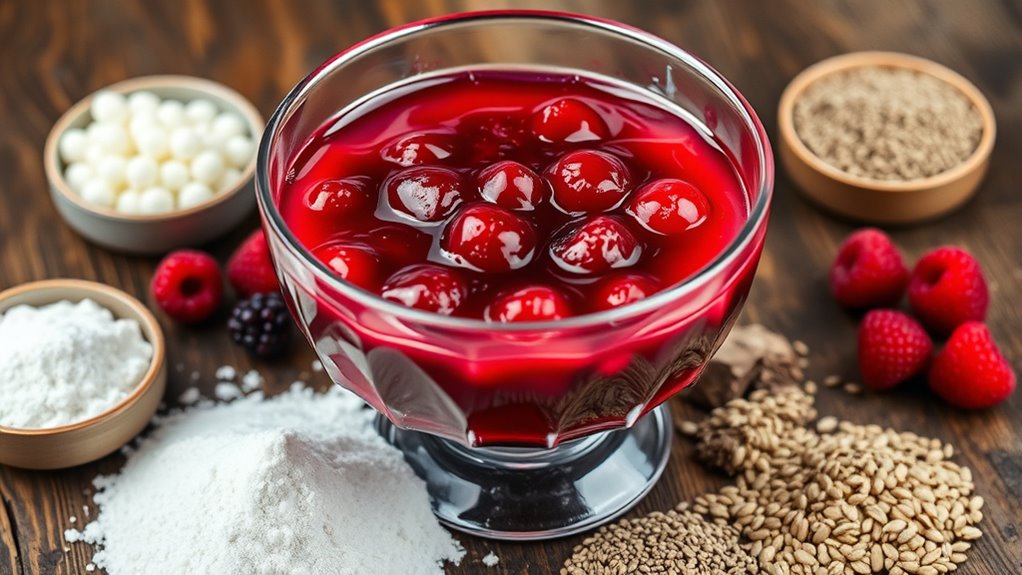For gluten-free desserts, natural thickeners like coconut flour, chia seeds, arrowroot starch, and tapioca starch work well to add texture and structure. Gelling agents like gelatin and agar-agar create firm, smooth surfaces, while pectin helps fruit-based treats set and shine. Combining these thickeners carefully and adjusting amounts guarantees perfect consistency. If you want tips on troubleshooting or combining these ingredients effectively, explore further to master your gluten-free desserts.
Key Takeaways
- Natural thickeners like coconut flour, chia seeds, arrowroot, and tapioca starch are common in gluten-free desserts.
- Gelling agents such as gelatin and agar-agar provide structure and firmness, with agar-agar being plant-based.
- Pectin helps fruit-based desserts set and adds shine, preventing separation and wateriness.
- Arrowroot creates clear, glossy gels, ideal for fruit sauces; tapioca offers chewy, elastic textures in puddings and fillings.
- Combining thickeners can enhance texture; adjust quantities carefully and troubleshoot clumping by proper mixing and heating.
Popular Natural Thickeners for Gluten-Free Desserts
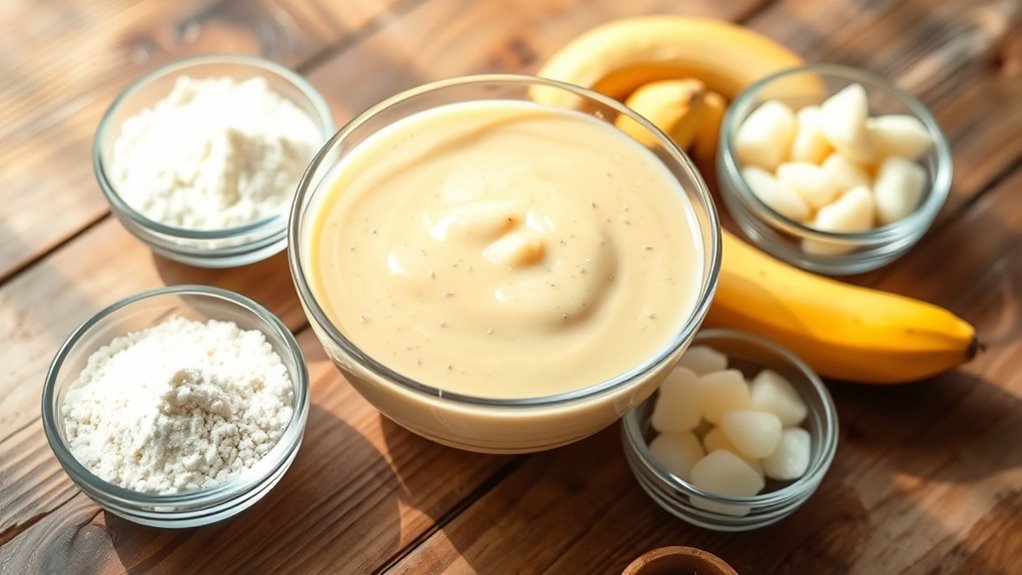
When it comes to creating delicious gluten-free desserts, selecting the right natural thickener can make all the difference. Popular options include coconut flour, which adds thickness and a subtle sweetness, and chia seeds, known for their gel-forming properties when soaked. Arrowroot starch is another versatile thickener that provides a clear, glossy finish, perfect for fruit sauces and puddings. Tapioca starch offers a chewy texture and excellent thickening power, especially in pie fillings. Nut butters, like almond or cashew, also serve as natural thickeners, adding richness and depth. These ingredients are naturally gluten-free and work well across various dessert recipes. Choosing the right thickener depends on your desired texture, flavor, and the specific dessert you’re making. Additionally, understanding the sustainability in food production ensures you select ingredients that support ethical and environmentally friendly practices.
How Gelatin and Agar-Agar Work as Thickeners
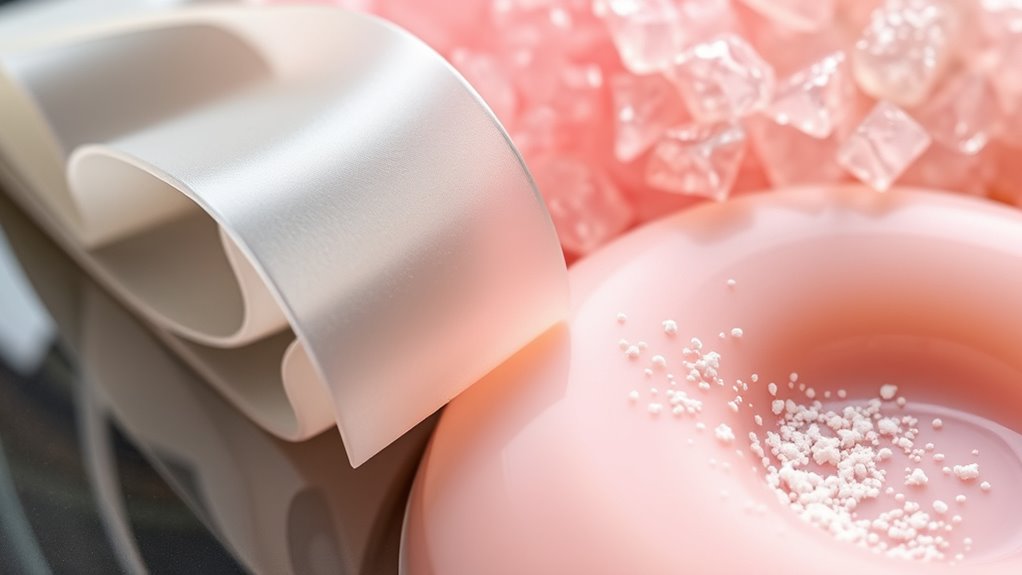
Gelatin and agar-agar are natural gelling agents that also serve as effective thickeners in gluten-free desserts. When you use gelatin, it dissolves in warm liquid and forms a gel as it cools, trapping moisture and giving your dessert a smooth, firm texture. Agar-agar, derived from seaweed, works similarly but sets at room temperature and doesn’t require refrigeration. It creates a firmer, more brittle gel compared to gelatin. Both work by forming a network of fibers that hold liquids in place, giving your dessert structure and consistency. Understanding contrast ratio is important because it affects the perceived sharpness and clarity of the finished product. Additionally, the gelation process can be influenced by pH and other ingredients, affecting the final texture.
- Gelatin requires heating to dissolve but sets as it cools
- Agar-agar sets quickly at room temperature
- Gelatin is animal-based, agar-agar is plant-based
- You can adjust firmness by changing the amount used
The Role of Pectin in Fruit-Based Desserts
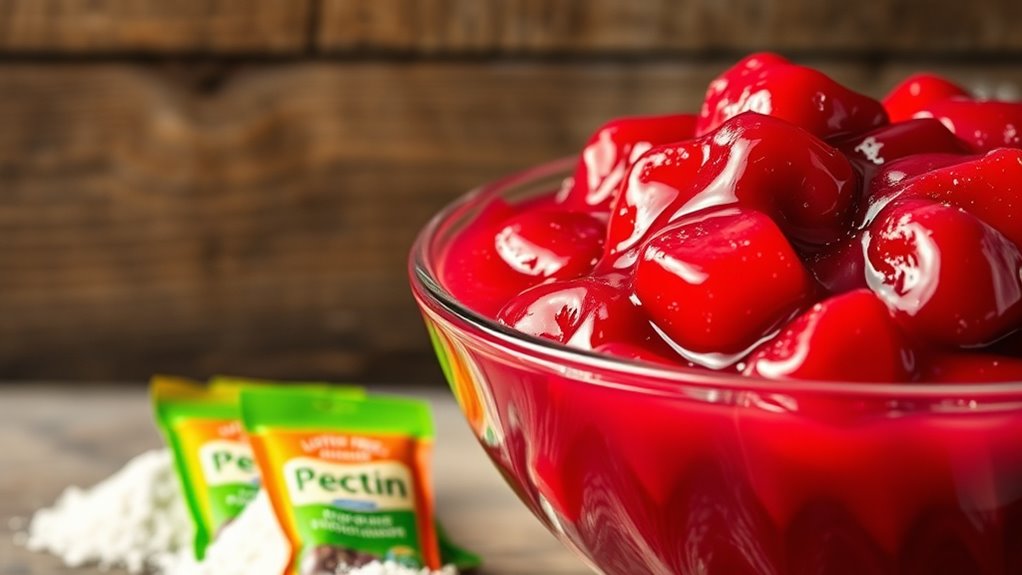
Pectin acts as a natural gelling agent that helps your fruit desserts set perfectly. It also enhances the texture and adds a lovely shine to your creations. When combined with fruit pectins, it creates a smooth, cohesive consistency that elevates your dessert. Incorporating glycolic acid products can inspire creative ways to display and store your dessert ingredients for easy access. Additionally, understanding juice extraction from oranges can help you incorporate fresh citrus juices into your desserts for added flavor and natural sweetness. Properly managing dessert storage ensures your desserts stay fresh and maintain their ideal texture. Knowing the divorce process and requirements can also be useful for understanding how to manage legal aspects of life changes that might affect your culinary routines.
Natural Gelling Agent
Have you ever wondered how fruit-based desserts achieve their smooth, cohesive texture without gluten? The answer lies in natural gelling agents like pectin. Pectin is a soluble fiber found in fruit cell walls that forms a gel when heated with sugar and acid. This gelation process creates the thick, jelly-like consistency you enjoy in jams, jellies, and fruit fillings. When you cook fruit with pectin, it activates and helps the dessert set without added thickeners. Pectin’s versatility makes it perfect for gluten-free recipes. It’s especially effective with berries, apples, and citrus fruits. Plus, it’s a plant-based, natural option that’s easy to work with, giving your desserts that ideal texture while keeping them gluten-free and wholesome. Understanding the dream symbolism of natural ingredients like pectin can also enhance your appreciation of wholesome cooking.
Enhances Texture and Shine
When you incorporate pectin into fruit-based desserts, it actively improves both texture and shine, giving your creations a polished appearance. Pectin creates a smooth, gel-like consistency that enhances the mouthfeel, making each bite more satisfying. It also helps distribute fruit juices evenly, preventing unwanted separation or a watery surface. The shine comes from pectin’s ability to form a glossy finish, making your desserts look more appealing and professional. This natural thickener ensures your fruit fillings and toppings remain firm yet tender, adding a refined touch to pies, tarts, and jams. By stabilizing the fruit’s natural juices and creating a uniform texture, pectin elevates the overall presentation and sensory experience of your dessert, making it look as good as it tastes. Incorporating knowledge of market research can also help you choose the best pectin type for your specific dessert needs.
Works With Fruit Pectins
In fruit-based desserts, pectin works synergistically with natural fruit components to create a cohesive and appealing final product. It helps thicken jams, jellies, and pie fillings by forming a gel-like structure when heated with sugar and acid. Pectin’s natural properties enhance the texture, making desserts smoother and more stable. When you add pectin to fruit mixtures, it interacts with the fruit’s natural pectins, boosting gel formation and consistency. This ensures your dessert holds together without becoming too firm or runny. Additionally, understanding the digital literacy of your ingredients can help you better control the final texture and appearance of your dessert. Recognizing the rustic aesthetic of the ingredients can also influence how you balance flavors and presentation, ensuring a more authentic farmhouse-style finish. For optimal results, selecting the right type of pectin based on your effectiveness needs can make a significant difference. Being aware of the chemical interactions involved can further optimize your thickening process and achieve the desired consistency. Knowing how precious metals perform during processing can also offer insights into the stability and longevity of your finished dessert.
Using Arrowroot and Tapioca Starch for Thickness
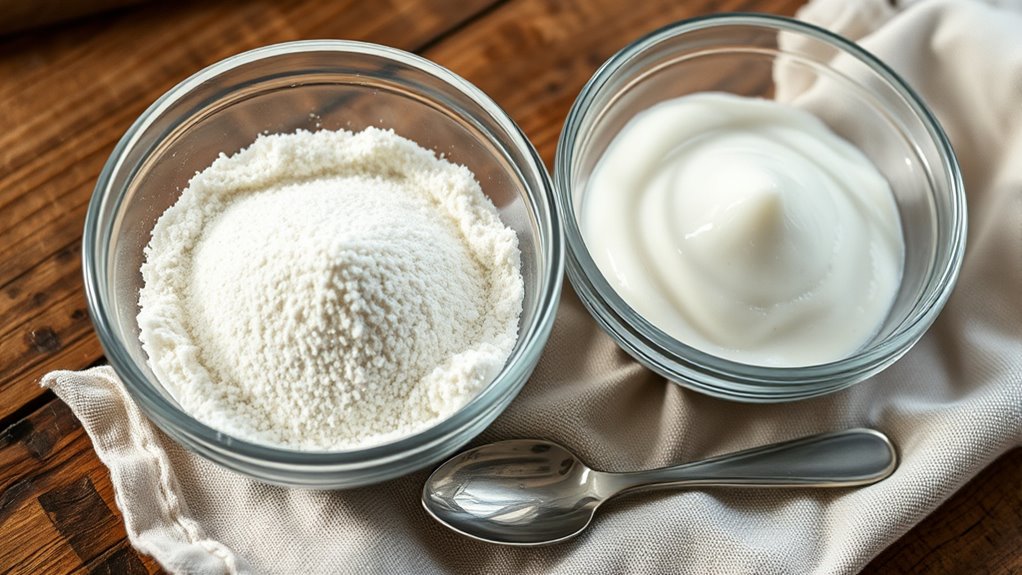
Arrowroot and tapioca starch are popular gluten-free options for thickening desserts, but they differ in strength and clarity. Understanding their thickening power helps you choose the best one for your recipe, while knowing their ideal uses guarantees perfect results. Let’s explore how these starches compare and share tips for using them effectively.
A key consideration is their symptoms of breast cancer, which can influence dietary choices and awareness about health.
Subheading 1: Thickening Power Comparison
While both arrowroot and tapioca starch are popular gluten-free thickeners, they differ markedly in their thickening power. Arrowroot creates a glossy, clear gel with a moderate thickening ability, making it ideal for delicate desserts. Tapioca starch, on the other hand, provides a stronger, more elastic texture, thickening quickly and efficiently. You’ll notice that you need less tapioca starch to achieve the same consistency as arrowroot, which can be more cost-effective. Keep in mind that tapioca tends to give a slightly chewy feel, while arrowroot keeps things smooth. If you want a shiny, transparent finish, arrowroot is your go-to. For a chewy, stretchy texture, tapioca is the better choice.
- Arrowroot offers a more delicate, glossy finish
- Tapioca provides stronger, quicker thickening
- Less tapioca is needed for the same thickness
- Arrowroot keeps desserts clear and smooth
Subheading 2: Best Uses & Tips
To get the best results when using arrowroot or tapioca starch as thickeners, it’s important to recognize their ideal applications and follow some practical tips. Arrowroot works best in clear liquids like fruit sauces or jellies, as it creates a glossy finish without clouding the dish. Use it at the end of cooking to prevent breakdown. Tapioca starch is excellent for puddings and pie fillings, providing a smooth, chewy texture. Dissolve either starch in cold water before adding to hot liquids to prevent clumping. Avoid boiling for too long with arrowroot, as it can thin out or become slimy. Tapioca holds up better under prolonged heat, making it suitable for longer cooking times. Both starches should be used sparingly—start with small amounts and adjust as needed. Additionally, understanding the financial impact of different entertainment industries can help inform your culinary and lifestyle choices. Being aware of AI vulnerabilities, such as potential for bias or misuse, is also important when considering technological tools in food innovation or consumption. Recognizing the best thickening agents for each dish can help you achieve the desired texture more effectively. Knowing how each starch interacts with different ingredients can also help prevent unwanted culinary mishaps and improve overall results.
Tips for Combining Gluten-Free Thickening Agents

Combining gluten-free thickening agents can enhance the texture and stability of your desserts, but it requires some careful planning. Mixing different thickeners allows you to achieve your desired consistency while balancing flavor and clarity. Start with small amounts to see how they interact, as some thickeners can overpower others if used excessively. Consider pairing a neutral thickener like cornstarch with a more flavor-rich one such as arrowroot. Remember that heat and timing affect thickening—add thickeners gradually and stir constantly. Keep in mind that some combinations may create a slightly different mouthfeel, so testing in small batches helps refine your approach. Additionally, understanding cybersecurity vulnerabilities can help you choose the most suitable thickeners for your specific dessert. Being aware of digital safety concerns can also help protect your recipes and personal information when researching or sharing your culinary creations online. To optimize your results, consider the composition of ingredients to ensure compatibility and achieve the best possible texture. Incorporating knowledge about food science principles can further improve your success with gluten-free thickening techniques.
Adjusting Consistency and Texture in Your Recipes
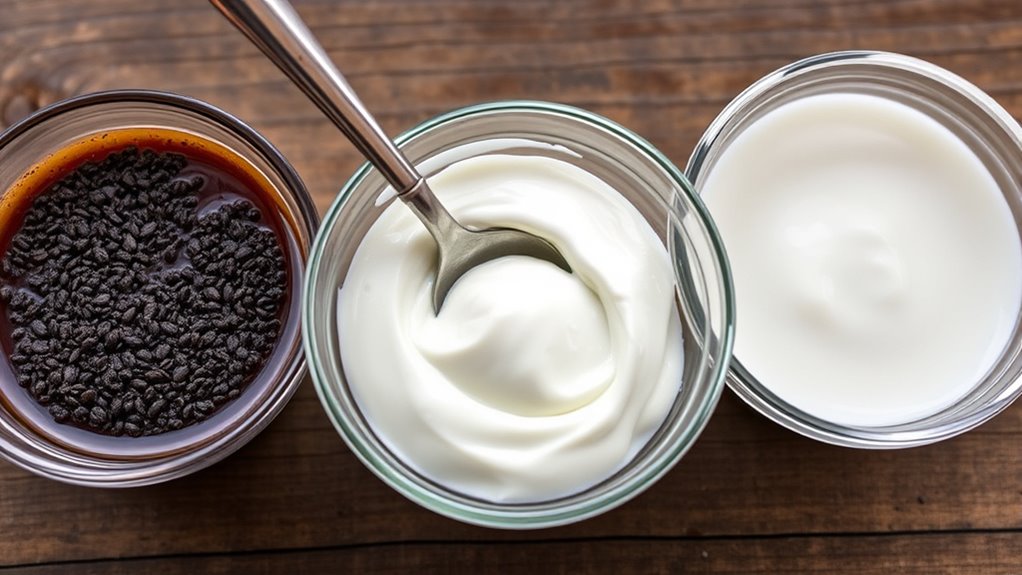
Adjusting the consistency and texture of your gluten-free desserts guarantees they turn out just right every time. If your dessert feels too thick, gently fold in a small amount of liquid—like dairy, fruit juice, or plant-based milk—until it reaches your desired smoothness. Conversely, if it’s too runny, add a bit more thickening agent, such as gluten-free starch or pureed fruit, to firm it up. Keep in mind that some thickeners, like cornstarch or arrowroot, can intensify as they cool, so test the consistency before the final set. Tasting as you go helps you gauge adjustments. Understanding cookie categories can help you choose the best thickeners for your needs. With a little practice, you’ll confidently modify your recipes to achieve the perfect balance of creaminess, firmness, and mouthfeel every time.
Troubleshooting Common Thickening Issues

When thickening your gluten-free desserts, issues can arise that affect the final texture, such as lumps, separation, or uneven consistency. To guarantee these problems, start by gently whisking or stirring the mixture to break up lumps. If separation occurs, try reheating and stirring continuously to reincorporate ingredients. Using cold liquids can cause clumping, so add warm or room-temperature liquids gradually. Overcooking can also break down thickeners, so keep an eye on the heat. Here are some tips to troubleshoot common issues:
Gently whisk, gradually add warm liquids, and monitor heat to prevent lumps and separation in gluten-free desserts.
- Sift dry ingredients before adding to prevent lumps
- Stir continuously during heating to ensure even thickening
- Adjust cooking time based on the thickener used
- Use a whisk or immersion blender for smoother results
Frequently Asked Questions
Can Gluten-Free Thickeners Affect the Flavor of Desserts?
You might wonder if gluten-free thickeners affect dessert flavor. Generally, they don’t substantially change the taste, but some can add a subtle flavor or texture, like arrowroot or tapioca giving a slight sweetness or chewiness. It’s crucial to choose the right thickener for your dessert to make sure the flavor remains true. Experimenting with small amounts helps you find the perfect balance without compromising taste or texture.
Are There Any Allergenic Concerns With Natural Gluten-Free Thickeners?
You might think allergenic concerns are tiny, but they can be huge! Natural gluten-free thickeners like guar gum, xanthan gum, or arrowroot are generally safe, but some people might react to them, especially if they have sensitivities or allergies to ingredients in their production. Always check labels carefully and consult with a healthcare professional if you have severe allergies. Your health is worth paying attention to, even with natural ingredients.
How Long Do Gluten-Free Thickeners Take to Set?
You’re wondering how long gluten-free thickeners take to set. Typically, it depends on the type you use. Gelatin or agar-agar can set within 30 minutes to an hour in the fridge, while cornstarch or arrowroot dissolve and thicken almost instantly when heated. For best results, follow the specific recipe instructions and allow adequate chilling time to achieve the desired consistency.
Can I Use These Thickeners in Cold Desserts?
You can definitely use gluten-free thickeners in cold desserts. Many work well when chilled, like agar agar or gelatin, which set as they cool. Just follow the instructions for each thickener, as some may need to be dissolved in warm liquid first. Once mixed and cooled, your dessert should thicken nicely. Keep in mind, the texture might differ slightly from traditional thickeners, but they still provide great results.
Are Gluten-Free Thickeners Suitable for Vegans?
You might wonder if gluten-free thickeners are vegan-friendly. Many are, like cornstarch, arrowroot, and tapioca, which come from plants and contain no animal products. However, some thickeners, like gelatin, aren’t suitable for vegans. Always check labels and ingredients to verify the product aligns with your vegan lifestyle. By doing so, you can enjoy your desserts without compromising your dietary choices.
Conclusion
Now that you know the ins and outs of gluten-free dessert thickeners, you’re ready to roll up your sleeves and get creative in the kitchen. With the right tools, you can turn any recipe into a luscious treat without breaking a sweat. Remember, patience is a virtue—sometimes you have to tinker a little to perfect that perfect texture. So go ahead, give it a shot, and don’t be afraid to think outside the box!
